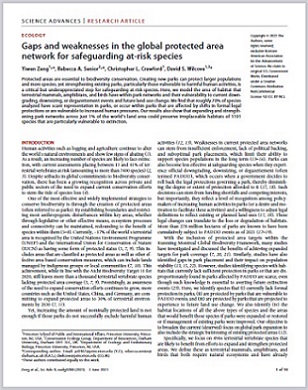
Protected areas are essential to biodiversity conservation. Creating new parks can protect larger populations and more species, yet strengthening existing parks, particularly those vulnerable to harmful human activities, is a critical but underappreciated step for safeguarding at-risk species. Here, we model the area of habitat that terrestrial mammals, amphibians, and birds have within park networks and their vulnerability to current downgrading, downsizing, or de-gazettement events and future land-use change. We find that roughly 70% of species analyzed have scant representation in parks, or occur within parks that are affected by shifts in formal legal protections or are vulnerable to increased human pressures. Our results also show that expanding and strengthening park networks across just 1% of the world’s land area could preserve irreplaceable habitats of 1191 species that are particularly vulnerable to extinction.














